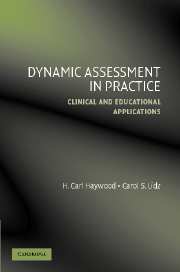Book contents
- Frontmatter
- Contents
- Preface
- Foreword, by Kenneth A. Dodge
- Foreword, by Thomas Oakland
- PART ONE THEORY AND PRINCIPLES
- PART TWO APPLICATIONS
- 4 Dynamic Assessment in Clinical Settings
- 5 Dynamic Assessment in Educational Settings
- 6 Applying Dynamic Assessment with Young Children
- 7 Applying Dynamic Assessment with School-Age Children
- 8 Applying Dynamic Assessment with Adults and Seniors
- 9 Writing Reports and Developing IEPs and Service Plans with Dynamic Assessment
- 10 Unresolved Issues, Conclusions, and Recommendations
- APPENDIX A TESTS REFERRED TO IN THE TEXT THAT DO NOT BELONG TO THE AUTHORS
- APPENDIX B SOURCES OF DYNAMIC ASSESSMENT MATERIALS
- References
- Author Index
- Subject Index
- Tests and Testing Materials Index
5 - Dynamic Assessment in Educational Settings
Published online by Cambridge University Press: 04 December 2009
- Frontmatter
- Contents
- Preface
- Foreword, by Kenneth A. Dodge
- Foreword, by Thomas Oakland
- PART ONE THEORY AND PRINCIPLES
- PART TWO APPLICATIONS
- 4 Dynamic Assessment in Clinical Settings
- 5 Dynamic Assessment in Educational Settings
- 6 Applying Dynamic Assessment with Young Children
- 7 Applying Dynamic Assessment with School-Age Children
- 8 Applying Dynamic Assessment with Adults and Seniors
- 9 Writing Reports and Developing IEPs and Service Plans with Dynamic Assessment
- 10 Unresolved Issues, Conclusions, and Recommendations
- APPENDIX A TESTS REFERRED TO IN THE TEXT THAT DO NOT BELONG TO THE AUTHORS
- APPENDIX B SOURCES OF DYNAMIC ASSESSMENT MATERIALS
- References
- Author Index
- Subject Index
- Tests and Testing Materials Index
Summary
In this chapter we review the substantial body of work that addresses the need to link information from assessment to intervention in educational settings. The focus, of course, is on dynamic assessment approaches that have been designed and implemented for this purpose. Use of dynamic procedures very much reflects the increased concern in education, and particularly in special education, for assessment to inform instruction rather than lead primarily to generation of diagnostic labels or classifications for program eligibility. The pressure on regular education to meet the needs of all learners continues, and, even in the most restrictive environments, teachers need help implementing their students' individualized education plans. It is no longer sufficient to limit prescriptions to objectives or outcomes. More and more, the call one hears is for realistic ideas for reaching these desired states, and these ideas should reflect data-based evidence; however, one cannot rely solely on research conducted with large groups for the supporting data. Group research can generate useful hypotheses and set directions for program planning but does not accurately target the needs or resources of individual students. Teachers and parents want to know what works specifically for their children, and dynamic assessment provides a basis for generating this information.
In Chapter 7, we describe a procedure for addressing this need: curriculum-based dynamic assessment. This chapter focuses on what others have proposed and designed and the evidence they have produced for dynamic procedures that involve specific curriculum content.
- Type
- Chapter
- Information
- Dynamic Assessment in PracticeClinical and Educational Applications, pp. 74 - 90Publisher: Cambridge University PressPrint publication year: 2006



